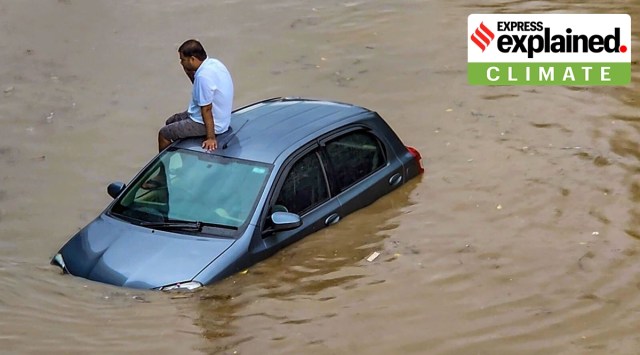Since 2013, ‘extreme’ rainfall events each year but few lessons learnt
These are exactly the kind of events that scientists have been warning for several years now: That rainfall would become more intense and concentrated — very heavy rainfall over short periods of time — and that their frequency would increase.
 A stranded commuter at Subhash Chowk in Gurgaon, Sunday. (PTI)
A stranded commuter at Subhash Chowk in Gurgaon, Sunday. (PTI) After the Uttarakhand disaster of 2013, there has not been a single year when India has not had at least one major extreme rainfall event, one that resulted in large-scale flooding, destruction and, in most cases, loss of lives.
Such events have happened in Kashmir, Chennai, Bengaluru, Pune, Mumbai, Gurgaon, Kerala, Assam, Bihar and many other places.
These are exactly the kind of events that scientists have been warning for several years now: That rainfall would become more intense and concentrated — very heavy rainfall over short periods of time – and that the frequency of such events would increase.
The current spell of heavy rainfall over northern India is simply a part of this trend, and is hardly a surprise, even if it happens to be the most intense rainfall in the last 20 or 25 years at some places. Much more extreme weather events are happening across the world with an alarming regularity.

Extreme events themselves might have become inevitable, but the disasters they result in are not necessarily so. In most cases, there is an aggravating factor involved, comprising official incompetence, neglect, callousness and, often, greed.
Bengaluru gets flooded every year not because it gets an unusual amount of rain but mainly because the natural channels of water flow beneath the surface have been blocked by irregular construction.
 The Beas oveflows in Mandi, Himachal Pradesh. (ANI)
The Beas oveflows in Mandi, Himachal Pradesh. (ANI)
Srinagar faced unprecedented flooding in 2014 not just due to very heavy rain – in just four days in September that year, it received rainfall that was more than five times the normal for the entire month – but also because all the low-lying areas along the passing Jhelum river have been populated.
Kerala, no stranger to heavy rainfall, saw widespread destruction in 2018, mainly because of the large number of settlements and tourist infrastructure that have come up on the floodplains of the rivers. Mumbai gets flooded at every opportunity because its drainage is broken or clogged.
The Uttarakhand disaster itself, as was pointed out in investigation reports later, was aggravated by unregulated construction and ill-planned infrastructure works.
Each of these events in the last 10 years has served a warning, and each of them has offered a number of learnings. Unfortunately, very few lessons, if any, seem to have been learnt. India is still in the process of building its infrastructure – roads, ports, railways, urban spaces, housing, hospital, power stations. It has the opportunity to design them in such a way that they are resilient to the worst expected impacts of climate change for the next four to five decades.
It is futile to blame the rain for the widespread waterlogging seen in Delhi, Gurgaon and other places in the last few days. Noida, with the same amount of rainfall, has been wearing a completely different look.
- 01
- 02
- 03
- 04
- 05






































